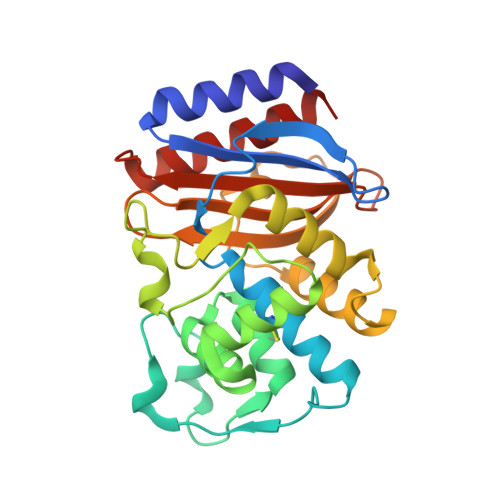Increased folding stability of TEM-1 beta-lactamase by in vitro selection
Kather, I., Jakob, R.P., Dobbek, H., Schmid, F.X.(2008) J Mol Biol 383: 238-251
- PubMed: 18706424
- DOI: https://doi.org/10.1016/j.jmb.2008.07.082
- Primary Citation of Related Structures:
3DTM - PubMed Abstract:
In vitro selections of stabilized proteins lead to more robust enzymes and, at the same time, yield novel insights into the principles of protein stability. We employed Proside, a method of in vitro selection, to find stabilized variants of TEM-1 beta-lactamase from Escherichia coli. Proside links the increased protease resistance of stabilized proteins to the infectivity of a filamentous phage. Several libraries of TEM-1 beta-lactamase variants were generated by error-prone PCR, and variants with increased protease resistance were obtained by raising temperature or guanidinium chloride concentration during proteolytic selections. Despite the small size of phage libraries, several strongly stabilizing mutations could be obtained, and a manual combination of the best shifted the profiles for thermal unfolding and temperature-dependent inactivation of beta-lactamase by almost 20 degrees C to a higher temperature. The wild-type protein unfolds in two stages: from the native state via an intermediate of the molten-globule type to the unfolded form. In the course of the selections, the native protein was stabilized by 27 kJ mol(-1) relative to the intermediate and the cooperativity of unfolding was strongly increased. Three of our stabilizing replacements (M182T, A224V, and R275L) had been identified independently in naturally occurring beta-lactamase variants with extended substrate spectrum. In these variants, they acted as global suppressors of destabilizations caused by the mutations in the active site. The comparison between the crystal structure of our best variant and the crystal structure of the wild-type protein indicates that most of the selected mutations optimize helices and their packing. The stabilization by the E147G substitution is remarkable. It removes steric strain that originates from an overly tight packing of two helices in the wild-type protein. Such unfavorable van der Waals repulsions are not easily identified in crystal structures or by computational approaches, but they strongly reduce the conformational stability of a protein.
Organizational Affiliation:
Laboratorium für Biochemie und Bayreuther, Zentrum für Molekulare Biowissenschaften, Universität Bayreuth, 95440 Bayreuth, Germany.














